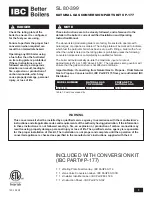
14
Solar circuit connection.
N.B.:
protect from overpressure caused by water
expansion during heating with a 0.6 MPa (6 bars)
valve, and with a closed diaphragm expansion
vessel. The operating pressure of the circuit must
not exceed 0.6 MPa (6 bars), and its temperature
must not be higher than 100°C. A glycol mixture
must be provided as heat transfer fluid for frost
and corrosion protection.
Removing the condensate.
N.B.:
cooling of the circulating air in contact with
the evaporator results in the water contained in
the air condensing. The condensed water flowing
down the back of the heat pump must be removed
from it and conveyed into suitable plastic pipes.
On the basis of air humidity,
up to 0.5 l/h of con-
densate may be formed
. The condensate run-off
must not be conveyed into the drain, since the
ammonia fumes that flow back from the drain
could damage the heat exchanger fins and parts of
the heat pump.
It is therefore obligatory to fit a siphon for the
discharge of waste water (do not use the pipe
supplied under any circumstances to make a
siphon). This connection must not in any case
be included in the safety unit.
2.4 AIR INTAKE CONNECTION.
When the volume of the room where the boiler is
installed is less than 20 m
3
, the appliance may be
connected to air ducts with diameter 160 mm. If
these ducts are not insulated, condensate might
form in them during appliance operation.
It is therefore essential to choose insulated air
ducts
(Fig. 2-11).
Poor-quality air ducts (crushed, too long, or
with too many bends, etc.) may cause a loss of
performance.
Flexible ducts are therefore definitely not
recommended
.
N.B.:
if there are connections to the ducts, adjust
fan settings accordingly.
N.B.:
the overall head loss on ducts and fittings
for discharge and intake of air
must be less than
130 Pa
. Calculation of load losses must be made
using the measurement instruments supplied
by the manufacturer, in accordance with the
proposed ducting accessories.
N.B.:
adjustable outlets may allow the use of
ducting bends to be reduced or dispensed with
altogether. For additional information on adjust-
able outlets, see Parag. 2.2.
2.5 ELECTRICAL CONNECTION.
Note:
the water heater can be electrically con-
nected only after being filled with water.
Note:
do not fit a programming clock or timing
devices that may interrupt the device's power
supply upstream of the water heater’s electrical
connection.
The water heater can be connected and operated
only with single-phase 230V AC power supply.
Connect the boiler with a cable having conductors
with 2.5 mm² section. Installation shall consist of:
- a circuit breaker or 16A multi-pole fuse with
contacts compliant with regulations in force.
- A 30 mA differential circuit breaker.
If the power cable is damaged, for safety reasons
it must be replaced by the manufacturer, the
after-sales service or similarly qualified staff.
N.B.:
earthing is obligatory.
Do not connect the power supply directly to the
electrical resistance.
The safety thermostat with which the electrical
integration is fitted must not be tampered with; if
required, it may be repaired/serviced exclusively
by skilled and qualified staff, according to the
instructions provided by Immergas.
Failure to comply with this clause shall void
the warranty
.
The appliance must be installed in compliance
with the provisions of the regulations in force.
Installation with connection to a Plus boiler
(model “SOL”).
In the “SOL” version, the internal heat exchanger
may be used in alternative to Solar connection,
to connect a boiler.
There is a pre-arrangement for electrical connec-
tion to the boiler, to be made through terminals
C1 and C2 (clean contact); this contact might be
placed in series with the NTC probe connection
of a Plus (although this will lead to DHW probe
anomaly on the boiler - until there is no demand
and the probe is therefore interrupted).
The boiler is triggered with intake air tempera-
tures outside the correct RAPAX operation range,
or if the BOOST mode is active.
Photovoltaic self-consumption contact.
The water heater is equipped with a contact to
fully exploit the electricity produced by the PV
system, in order to accumulate thermal energy
within the storage tank (self-consumption).
Having an inverter/electronic device which
supplies a signal when PV production exceeds
a certain value at least higher than 450W, when
this contact is closed the boiler is triggered in heat
pump mode to heat the DHW up to 62°C, as long
as it is within the allowable ambient temperature
values (-5°C +43°C).
When the photovoltaic contact is opened, the
system goes back to the previous settings only
after about 5 minutes, to avoid alternating op-
eration caused by clouds or temporary shadows
.
See the instructions for removing the front
cover, and for access to the terminal block see
paragraph 4.5.
N.B.:
A cable channel is provided specifically
for this connection. Ensure it is used (Fig. 2-12).
External/External Coating
Type configurations
Air Outlets / Inlets
Roof
Wall-mounted
Roof
Wall-mounted
Roof
Wall-mounted
Max.
Lengths
L1 + L2
Isolated semi-rigid gal-
vanic sheath Ø 160 mm
12 m
12 m
5 m
10 m
PEHD Sheath
Ø 160 mm
28 m
26 m
16 m
24 m
N.B.:
the adjustable vents can allow to reduce or eliminate the use of coating elbows.
LENGTH OF THE AUTHORISED SHEATH















































